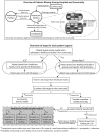The Regional Healthcare Ecosystem Analyst (RHEA): a simulation modeling tool to assist infectious disease control in a health system
- PMID: 23571848
- PMCID: PMC3715346
- DOI: 10.1136/amiajnl-2012-001107
The Regional Healthcare Ecosystem Analyst (RHEA): a simulation modeling tool to assist infectious disease control in a health system
Abstract
Objective: As healthcare systems continue to expand and interconnect with each other through patient sharing, administrators, policy makers, infection control specialists, and other decision makers may have to take account of the entire healthcare 'ecosystem' in infection control.
Materials and methods: We developed a software tool, the Regional Healthcare Ecosystem Analyst (RHEA), that can accept user-inputted data to rapidly create a detailed agent-based simulation model (ABM) of the healthcare ecosystem (ie, all healthcare facilities, their adjoining community, and patient flow among the facilities) of any region to better understand the spread and control of infectious diseases.
Results: To demonstrate RHEA's capabilities, we fed extensive data from Orange County, California, USA, into RHEA to create an ABM of a healthcare ecosystem and simulate the spread and control of methicillin-resistant Staphylococcus aureus. Various experiments explored the effects of changing different parameters (eg, degree of transmission, length of stay, and bed capacity).
Discussion: Our model emphasizes how individual healthcare facilities are components of integrated and dynamic networks connected via patient movement and how occurrences in one healthcare facility may affect many other healthcare facilities.
Conclusions: A decision maker can utilize RHEA to generate a detailed ABM of any healthcare system of interest, which in turn can serve as a virtual laboratory to test different policies and interventions.
Keywords: Healthcare System; Hospital Acquired Infections; Hospitals; Infectious Diseases; Patient Sharing.
Figures
References
-
- Office of Statewide Health Planning and Development MIRCal—inpatient data reporting manual, 7th edn, version 7.6, 2011; http://www.oshpd.ca.gov/HID/MIRCal/Text_pdfs/ManualsGuides/IPManual/TofC... (accessed Jun 2009).
-
- Healthcare Cost and Utilization Project (HCUP) HCUP databases. State Inpatient Databases (SID). Rockville, MD: Agency for Healthcare Research and Quality, 2013; http://www.hcup-us.ahrq.gov/sidoverview.jsp (accessed Jun 2009)
-
- Centers for Medicare and Medicaid Services Research Data Assistance Center (ResDAC). Long term care Minimum Data Set (MDS) 3.0. Minneapolis, MN: Centers for Medicare and Medicaid Services, 2011
Publication types
MeSH terms
Grants and funding
LinkOut - more resources
Full Text Sources
Other Literature Sources
Medical
Research Materials



